Organisational Behaviour Report: Culture, Teams, Motivation
VerifiedAdded on 2020/07/22
|13
|4062
|52
Report
AI Summary
This report examines organisational behaviour within the British Broadcasting Corporation (BBC). It explores the impact of culture, politics, and power on employee behaviour, referencing Handy's cultural typology and analyzing the BBC's historical and current organizational culture. The report then delves into content and process theories of motivation, assessing their effectiveness and impact on business outcomes. It also investigates team dynamics, comparing effective and ineffective teams using Tuckman and Jensen's models. Finally, the report applies organizational behaviour concepts, such as the path-goal theory, to improve team performance and discusses barriers to effective performance within the BBC. The analysis highlights the importance of organizational behaviour policies and theories in shaping employee behaviour and organizational success.
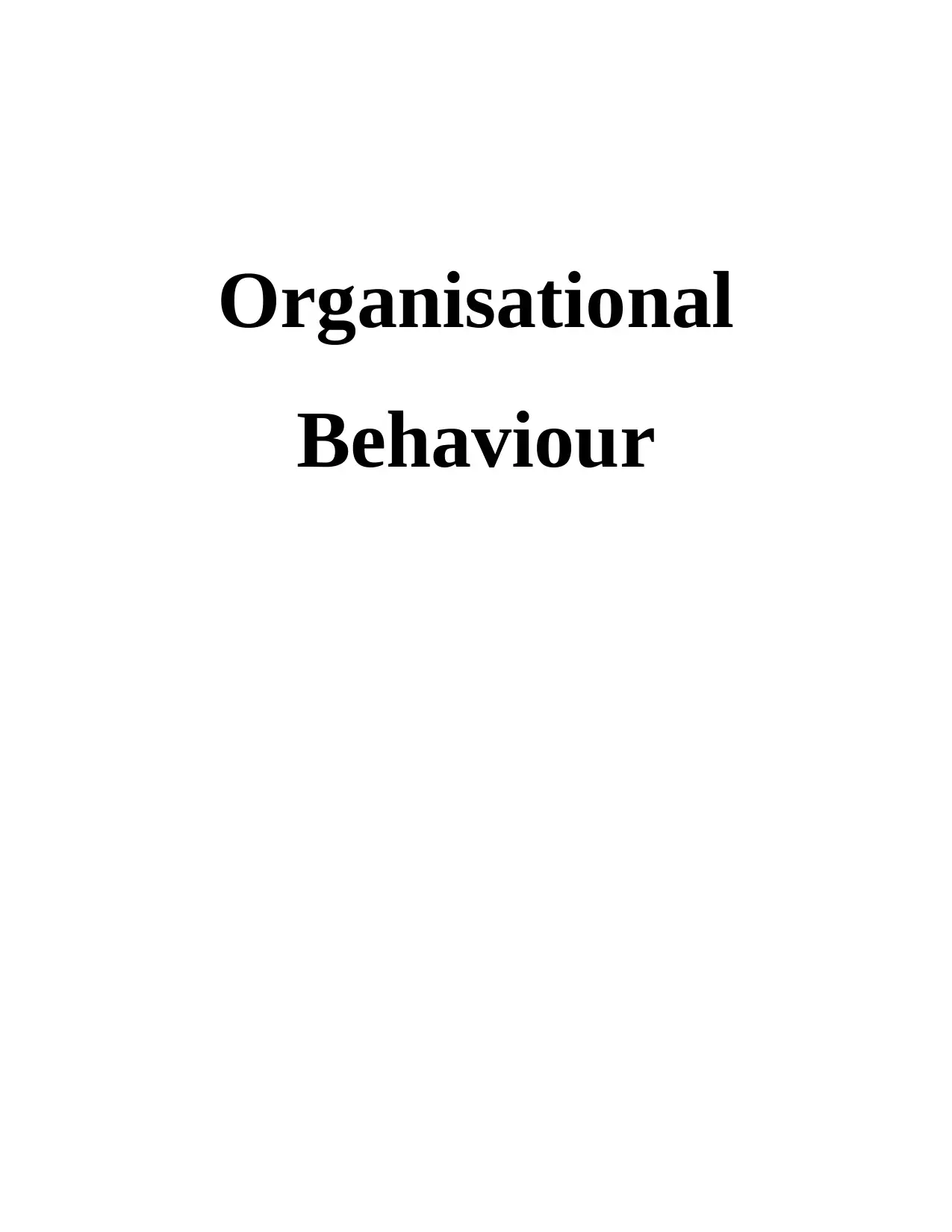
Organisational
Behaviour
Behaviour
Paraphrase This Document
Need a fresh take? Get an instant paraphrase of this document with our AI Paraphraser
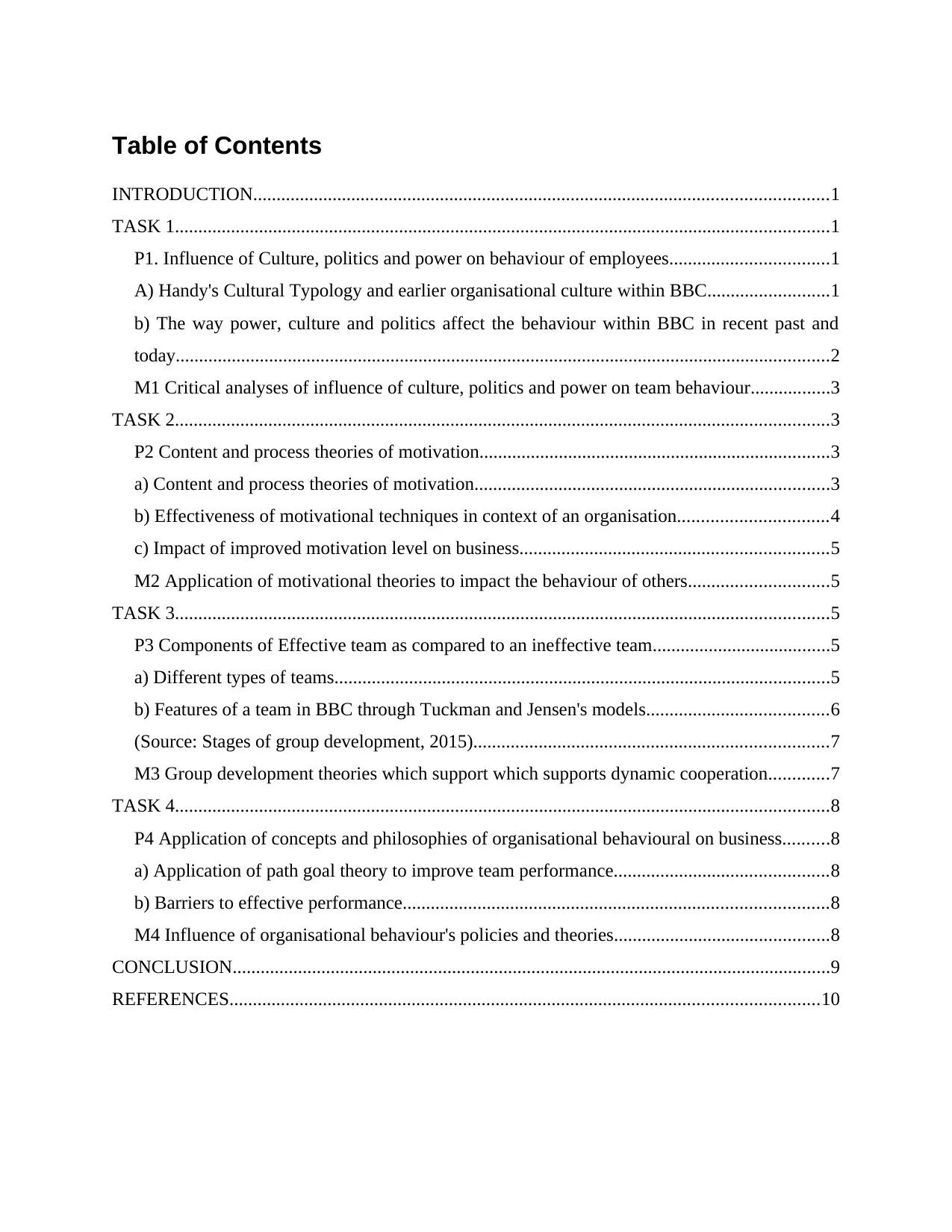
Table of Contents
INTRODUCTION...........................................................................................................................1
TASK 1............................................................................................................................................1
P1. Influence of Culture, politics and power on behaviour of employees..................................1
A) Handy's Cultural Typology and earlier organisational culture within BBC..........................1
b) The way power, culture and politics affect the behaviour within BBC in recent past and
today............................................................................................................................................2
M1 Critical analyses of influence of culture, politics and power on team behaviour.................3
TASK 2............................................................................................................................................3
P2 Content and process theories of motivation...........................................................................3
a) Content and process theories of motivation............................................................................3
b) Effectiveness of motivational techniques in context of an organisation................................4
c) Impact of improved motivation level on business..................................................................5
M2 Application of motivational theories to impact the behaviour of others..............................5
TASK 3............................................................................................................................................5
P3 Components of Effective team as compared to an ineffective team......................................5
a) Different types of teams..........................................................................................................5
b) Features of a team in BBC through Tuckman and Jensen's models.......................................6
(Source: Stages of group development, 2015)............................................................................7
M3 Group development theories which support which supports dynamic cooperation.............7
TASK 4............................................................................................................................................8
P4 Application of concepts and philosophies of organisational behavioural on business..........8
a) Application of path goal theory to improve team performance..............................................8
b) Barriers to effective performance...........................................................................................8
M4 Influence of organisational behaviour's policies and theories..............................................8
CONCLUSION................................................................................................................................9
REFERENCES..............................................................................................................................10
INTRODUCTION...........................................................................................................................1
TASK 1............................................................................................................................................1
P1. Influence of Culture, politics and power on behaviour of employees..................................1
A) Handy's Cultural Typology and earlier organisational culture within BBC..........................1
b) The way power, culture and politics affect the behaviour within BBC in recent past and
today............................................................................................................................................2
M1 Critical analyses of influence of culture, politics and power on team behaviour.................3
TASK 2............................................................................................................................................3
P2 Content and process theories of motivation...........................................................................3
a) Content and process theories of motivation............................................................................3
b) Effectiveness of motivational techniques in context of an organisation................................4
c) Impact of improved motivation level on business..................................................................5
M2 Application of motivational theories to impact the behaviour of others..............................5
TASK 3............................................................................................................................................5
P3 Components of Effective team as compared to an ineffective team......................................5
a) Different types of teams..........................................................................................................5
b) Features of a team in BBC through Tuckman and Jensen's models.......................................6
(Source: Stages of group development, 2015)............................................................................7
M3 Group development theories which support which supports dynamic cooperation.............7
TASK 4............................................................................................................................................8
P4 Application of concepts and philosophies of organisational behavioural on business..........8
a) Application of path goal theory to improve team performance..............................................8
b) Barriers to effective performance...........................................................................................8
M4 Influence of organisational behaviour's policies and theories..............................................8
CONCLUSION................................................................................................................................9
REFERENCES..............................................................................................................................10
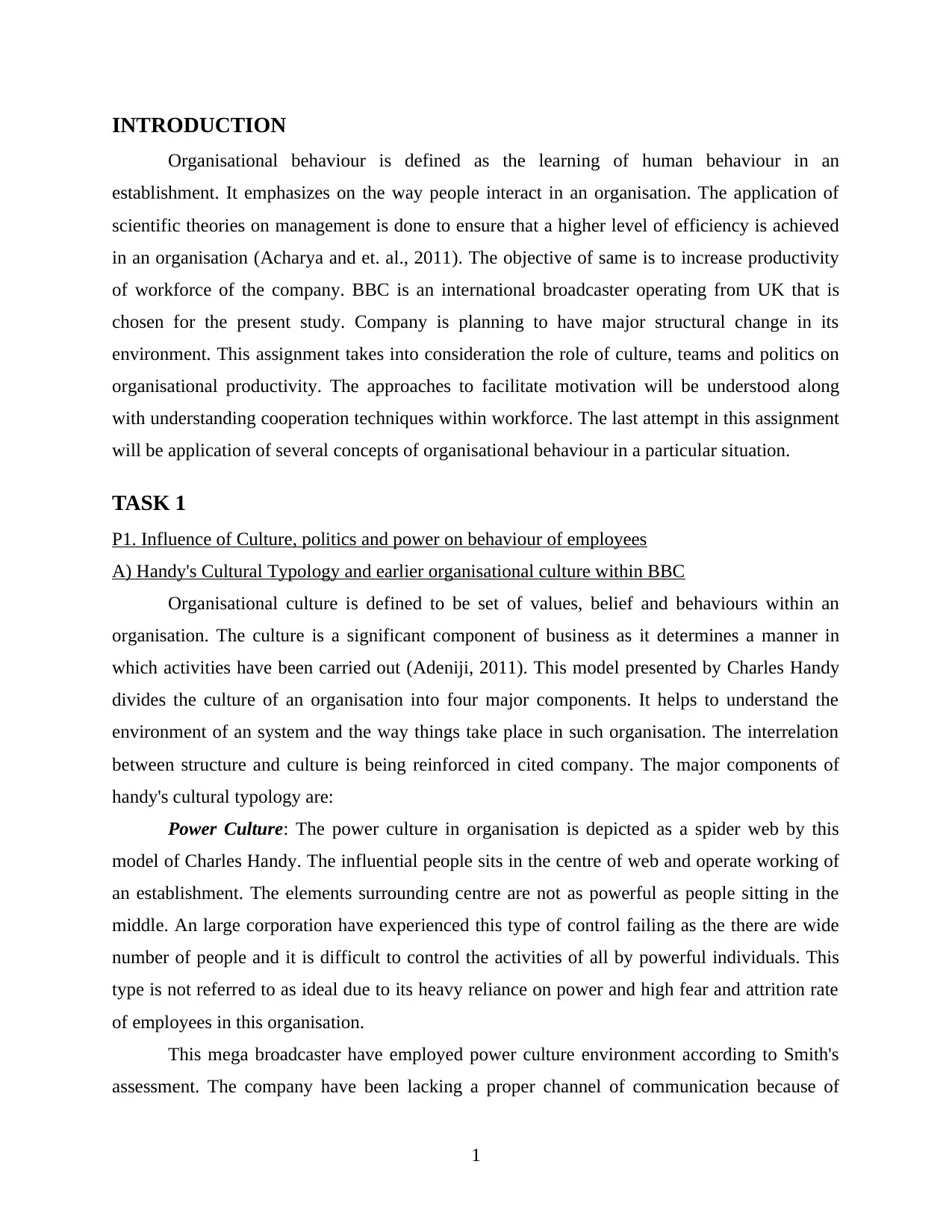
INTRODUCTION
Organisational behaviour is defined as the learning of human behaviour in an
establishment. It emphasizes on the way people interact in an organisation. The application of
scientific theories on management is done to ensure that a higher level of efficiency is achieved
in an organisation (Acharya and et. al., 2011). The objective of same is to increase productivity
of workforce of the company. BBC is an international broadcaster operating from UK that is
chosen for the present study. Company is planning to have major structural change in its
environment. This assignment takes into consideration the role of culture, teams and politics on
organisational productivity. The approaches to facilitate motivation will be understood along
with understanding cooperation techniques within workforce. The last attempt in this assignment
will be application of several concepts of organisational behaviour in a particular situation.
TASK 1
P1. Influence of Culture, politics and power on behaviour of employees
A) Handy's Cultural Typology and earlier organisational culture within BBC
Organisational culture is defined to be set of values, belief and behaviours within an
organisation. The culture is a significant component of business as it determines a manner in
which activities have been carried out (Adeniji, 2011). This model presented by Charles Handy
divides the culture of an organisation into four major components. It helps to understand the
environment of an system and the way things take place in such organisation. The interrelation
between structure and culture is being reinforced in cited company. The major components of
handy's cultural typology are:
Power Culture: The power culture in organisation is depicted as a spider web by this
model of Charles Handy. The influential people sits in the centre of web and operate working of
an establishment. The elements surrounding centre are not as powerful as people sitting in the
middle. An large corporation have experienced this type of control failing as the there are wide
number of people and it is difficult to control the activities of all by powerful individuals. This
type is not referred to as ideal due to its heavy reliance on power and high fear and attrition rate
of employees in this organisation.
This mega broadcaster have employed power culture environment according to Smith's
assessment. The company have been lacking a proper channel of communication because of
1
Organisational behaviour is defined as the learning of human behaviour in an
establishment. It emphasizes on the way people interact in an organisation. The application of
scientific theories on management is done to ensure that a higher level of efficiency is achieved
in an organisation (Acharya and et. al., 2011). The objective of same is to increase productivity
of workforce of the company. BBC is an international broadcaster operating from UK that is
chosen for the present study. Company is planning to have major structural change in its
environment. This assignment takes into consideration the role of culture, teams and politics on
organisational productivity. The approaches to facilitate motivation will be understood along
with understanding cooperation techniques within workforce. The last attempt in this assignment
will be application of several concepts of organisational behaviour in a particular situation.
TASK 1
P1. Influence of Culture, politics and power on behaviour of employees
A) Handy's Cultural Typology and earlier organisational culture within BBC
Organisational culture is defined to be set of values, belief and behaviours within an
organisation. The culture is a significant component of business as it determines a manner in
which activities have been carried out (Adeniji, 2011). This model presented by Charles Handy
divides the culture of an organisation into four major components. It helps to understand the
environment of an system and the way things take place in such organisation. The interrelation
between structure and culture is being reinforced in cited company. The major components of
handy's cultural typology are:
Power Culture: The power culture in organisation is depicted as a spider web by this
model of Charles Handy. The influential people sits in the centre of web and operate working of
an establishment. The elements surrounding centre are not as powerful as people sitting in the
middle. An large corporation have experienced this type of control failing as the there are wide
number of people and it is difficult to control the activities of all by powerful individuals. This
type is not referred to as ideal due to its heavy reliance on power and high fear and attrition rate
of employees in this organisation.
This mega broadcaster have employed power culture environment according to Smith's
assessment. The company have been lacking a proper channel of communication because of
1
⊘ This is a preview!⊘
Do you want full access?
Subscribe today to unlock all pages.

Trusted by 1+ million students worldwide

which issues which were faced by employees were not resolved. The people with power tries to
suppress the matters which could have resolved with investigation.
Role culture: Role culture is defined as an ideal circumstance in an organisation. An
organisation comprised of workforce which fulfils goals assigned to them. which are its capable
workforce. Every individual in the organisation is assigned with a task and held full accountable
for the same. The structures of such organisations are either functional or division based. An
ideal balance of authority and responsibilities will improve the productivity of an organisation.
Task Culture: This culture is task oriented. It aims to associate different resources of
organisation to achieve goals set by the same. This culture aims to create synergy within firm
which creates better and productive output of the tasks assigned. Team culture is promoted in
context of business environment and individual objectives are not given with much importance.
This is an ideal culture in context of large organisations. The large corporation divides
the people on the basis of divisions and functions. The application of task culture in an
organisation promotes efficiency and productivity. The company caters a wide diversified
segment therefore it is essential to divide teams on various grounds (Armache, 2012). Therefore
application of such culture will assist in achievement of goals and objectives of an organisation.
Person culture: This employee oriented culture can be found in some organisations.
Emphasis is on individual goals rather than objectives of company. A cluster is developed and
there is lack of control on the workers except terms formed by mutual consent of employees
working in the organisation.
b) The way power, culture and politics affect the behaviour within BBC in recent past and today
Power, culture and politics play a crucial role in influence the working of employees with
respect to organisation. Power defines the manner in which activities are carried out in an
organisation. The people with power influences decision making and retain control over the
whole organisation (Bolino and et. al., 2013). The centralised control is entertained by the
management. Power with a few person in the management fails to implement a communication
channel. Views and opinion of such member will be entertained exclusively. Whereas culture
defines the way in which people interact with each other. The situation of harmony and social
cohesion will carry a positive impact on the functioning of business and vice versa. This global
broadcaster employs around twenty thousand people and therefore, it is necessary to create a
right culture so that productivity of organisation can be enhanced. This organisation has been
2
suppress the matters which could have resolved with investigation.
Role culture: Role culture is defined as an ideal circumstance in an organisation. An
organisation comprised of workforce which fulfils goals assigned to them. which are its capable
workforce. Every individual in the organisation is assigned with a task and held full accountable
for the same. The structures of such organisations are either functional or division based. An
ideal balance of authority and responsibilities will improve the productivity of an organisation.
Task Culture: This culture is task oriented. It aims to associate different resources of
organisation to achieve goals set by the same. This culture aims to create synergy within firm
which creates better and productive output of the tasks assigned. Team culture is promoted in
context of business environment and individual objectives are not given with much importance.
This is an ideal culture in context of large organisations. The large corporation divides
the people on the basis of divisions and functions. The application of task culture in an
organisation promotes efficiency and productivity. The company caters a wide diversified
segment therefore it is essential to divide teams on various grounds (Armache, 2012). Therefore
application of such culture will assist in achievement of goals and objectives of an organisation.
Person culture: This employee oriented culture can be found in some organisations.
Emphasis is on individual goals rather than objectives of company. A cluster is developed and
there is lack of control on the workers except terms formed by mutual consent of employees
working in the organisation.
b) The way power, culture and politics affect the behaviour within BBC in recent past and today
Power, culture and politics play a crucial role in influence the working of employees with
respect to organisation. Power defines the manner in which activities are carried out in an
organisation. The people with power influences decision making and retain control over the
whole organisation (Bolino and et. al., 2013). The centralised control is entertained by the
management. Power with a few person in the management fails to implement a communication
channel. Views and opinion of such member will be entertained exclusively. Whereas culture
defines the way in which people interact with each other. The situation of harmony and social
cohesion will carry a positive impact on the functioning of business and vice versa. This global
broadcaster employs around twenty thousand people and therefore, it is necessary to create a
right culture so that productivity of organisation can be enhanced. This organisation has been
2
Paraphrase This Document
Need a fresh take? Get an instant paraphrase of this document with our AI Paraphraser
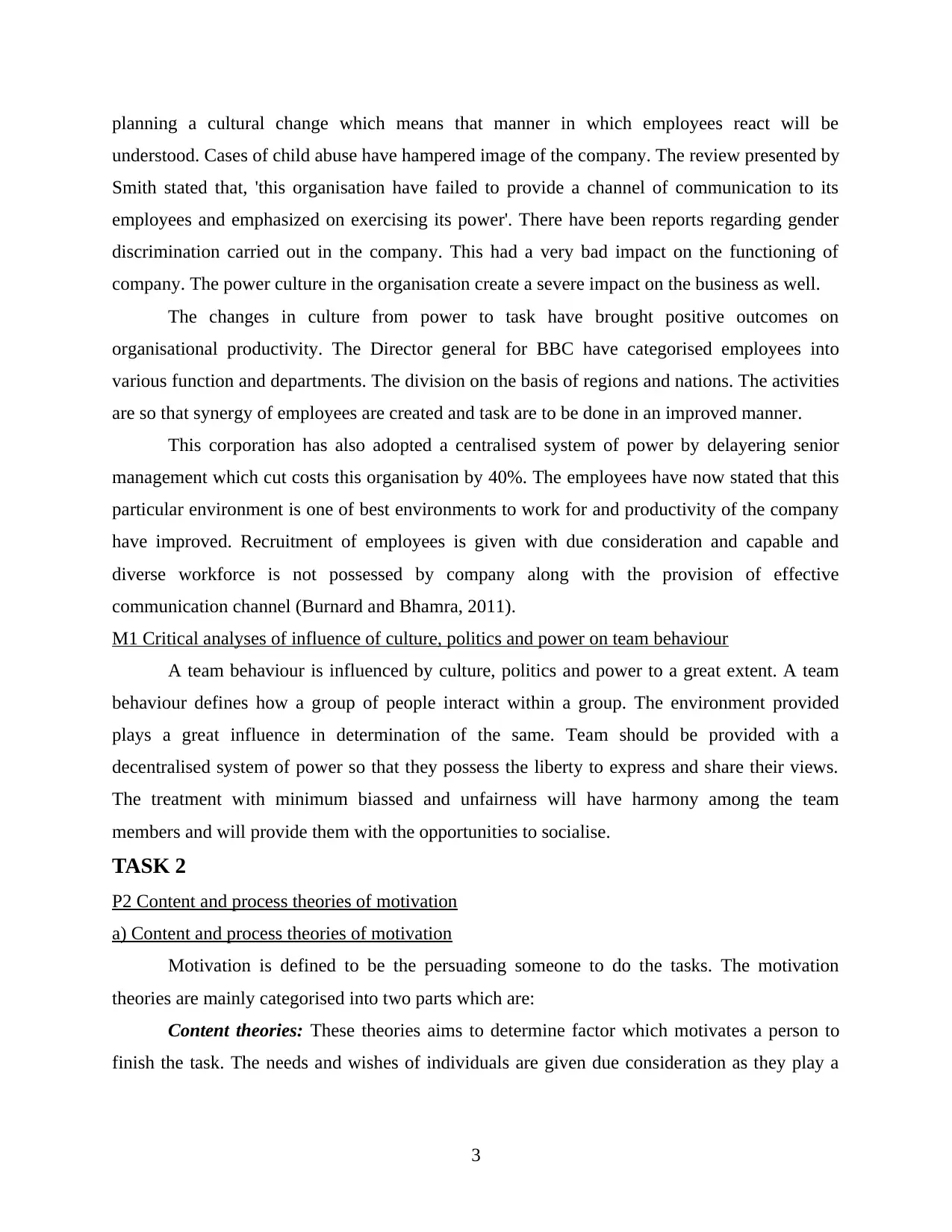
planning a cultural change which means that manner in which employees react will be
understood. Cases of child abuse have hampered image of the company. The review presented by
Smith stated that, 'this organisation have failed to provide a channel of communication to its
employees and emphasized on exercising its power'. There have been reports regarding gender
discrimination carried out in the company. This had a very bad impact on the functioning of
company. The power culture in the organisation create a severe impact on the business as well.
The changes in culture from power to task have brought positive outcomes on
organisational productivity. The Director general for BBC have categorised employees into
various function and departments. The division on the basis of regions and nations. The activities
are so that synergy of employees are created and task are to be done in an improved manner.
This corporation has also adopted a centralised system of power by delayering senior
management which cut costs this organisation by 40%. The employees have now stated that this
particular environment is one of best environments to work for and productivity of the company
have improved. Recruitment of employees is given with due consideration and capable and
diverse workforce is not possessed by company along with the provision of effective
communication channel (Burnard and Bhamra, 2011).
M1 Critical analyses of influence of culture, politics and power on team behaviour
A team behaviour is influenced by culture, politics and power to a great extent. A team
behaviour defines how a group of people interact within a group. The environment provided
plays a great influence in determination of the same. Team should be provided with a
decentralised system of power so that they possess the liberty to express and share their views.
The treatment with minimum biassed and unfairness will have harmony among the team
members and will provide them with the opportunities to socialise.
TASK 2
P2 Content and process theories of motivation
a) Content and process theories of motivation
Motivation is defined to be the persuading someone to do the tasks. The motivation
theories are mainly categorised into two parts which are:
Content theories: These theories aims to determine factor which motivates a person to
finish the task. The needs and wishes of individuals are given due consideration as they play a
3
understood. Cases of child abuse have hampered image of the company. The review presented by
Smith stated that, 'this organisation have failed to provide a channel of communication to its
employees and emphasized on exercising its power'. There have been reports regarding gender
discrimination carried out in the company. This had a very bad impact on the functioning of
company. The power culture in the organisation create a severe impact on the business as well.
The changes in culture from power to task have brought positive outcomes on
organisational productivity. The Director general for BBC have categorised employees into
various function and departments. The division on the basis of regions and nations. The activities
are so that synergy of employees are created and task are to be done in an improved manner.
This corporation has also adopted a centralised system of power by delayering senior
management which cut costs this organisation by 40%. The employees have now stated that this
particular environment is one of best environments to work for and productivity of the company
have improved. Recruitment of employees is given with due consideration and capable and
diverse workforce is not possessed by company along with the provision of effective
communication channel (Burnard and Bhamra, 2011).
M1 Critical analyses of influence of culture, politics and power on team behaviour
A team behaviour is influenced by culture, politics and power to a great extent. A team
behaviour defines how a group of people interact within a group. The environment provided
plays a great influence in determination of the same. Team should be provided with a
decentralised system of power so that they possess the liberty to express and share their views.
The treatment with minimum biassed and unfairness will have harmony among the team
members and will provide them with the opportunities to socialise.
TASK 2
P2 Content and process theories of motivation
a) Content and process theories of motivation
Motivation is defined to be the persuading someone to do the tasks. The motivation
theories are mainly categorised into two parts which are:
Content theories: These theories aims to determine factor which motivates a person to
finish the task. The needs and wishes of individuals are given due consideration as they play a
3
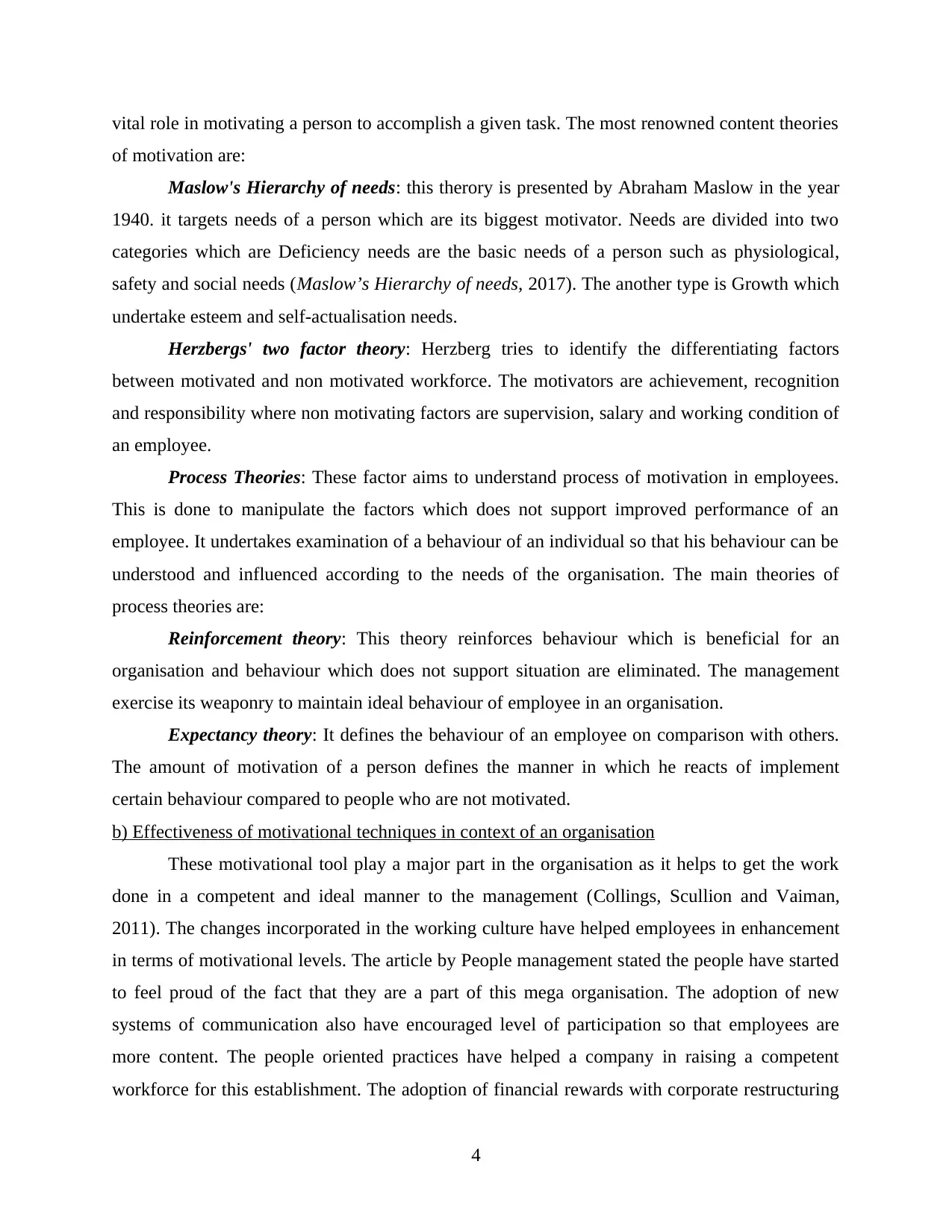
vital role in motivating a person to accomplish a given task. The most renowned content theories
of motivation are:
Maslow's Hierarchy of needs: this therory is presented by Abraham Maslow in the year
1940. it targets needs of a person which are its biggest motivator. Needs are divided into two
categories which are Deficiency needs are the basic needs of a person such as physiological,
safety and social needs (Maslow’s Hierarchy of needs, 2017). The another type is Growth which
undertake esteem and self-actualisation needs.
Herzbergs' two factor theory: Herzberg tries to identify the differentiating factors
between motivated and non motivated workforce. The motivators are achievement, recognition
and responsibility where non motivating factors are supervision, salary and working condition of
an employee.
Process Theories: These factor aims to understand process of motivation in employees.
This is done to manipulate the factors which does not support improved performance of an
employee. It undertakes examination of a behaviour of an individual so that his behaviour can be
understood and influenced according to the needs of the organisation. The main theories of
process theories are:
Reinforcement theory: This theory reinforces behaviour which is beneficial for an
organisation and behaviour which does not support situation are eliminated. The management
exercise its weaponry to maintain ideal behaviour of employee in an organisation.
Expectancy theory: It defines the behaviour of an employee on comparison with others.
The amount of motivation of a person defines the manner in which he reacts of implement
certain behaviour compared to people who are not motivated.
b) Effectiveness of motivational techniques in context of an organisation
These motivational tool play a major part in the organisation as it helps to get the work
done in a competent and ideal manner to the management (Collings, Scullion and Vaiman,
2011). The changes incorporated in the working culture have helped employees in enhancement
in terms of motivational levels. The article by People management stated the people have started
to feel proud of the fact that they are a part of this mega organisation. The adoption of new
systems of communication also have encouraged level of participation so that employees are
more content. The people oriented practices have helped a company in raising a competent
workforce for this establishment. The adoption of financial rewards with corporate restructuring
4
of motivation are:
Maslow's Hierarchy of needs: this therory is presented by Abraham Maslow in the year
1940. it targets needs of a person which are its biggest motivator. Needs are divided into two
categories which are Deficiency needs are the basic needs of a person such as physiological,
safety and social needs (Maslow’s Hierarchy of needs, 2017). The another type is Growth which
undertake esteem and self-actualisation needs.
Herzbergs' two factor theory: Herzberg tries to identify the differentiating factors
between motivated and non motivated workforce. The motivators are achievement, recognition
and responsibility where non motivating factors are supervision, salary and working condition of
an employee.
Process Theories: These factor aims to understand process of motivation in employees.
This is done to manipulate the factors which does not support improved performance of an
employee. It undertakes examination of a behaviour of an individual so that his behaviour can be
understood and influenced according to the needs of the organisation. The main theories of
process theories are:
Reinforcement theory: This theory reinforces behaviour which is beneficial for an
organisation and behaviour which does not support situation are eliminated. The management
exercise its weaponry to maintain ideal behaviour of employee in an organisation.
Expectancy theory: It defines the behaviour of an employee on comparison with others.
The amount of motivation of a person defines the manner in which he reacts of implement
certain behaviour compared to people who are not motivated.
b) Effectiveness of motivational techniques in context of an organisation
These motivational tool play a major part in the organisation as it helps to get the work
done in a competent and ideal manner to the management (Collings, Scullion and Vaiman,
2011). The changes incorporated in the working culture have helped employees in enhancement
in terms of motivational levels. The article by People management stated the people have started
to feel proud of the fact that they are a part of this mega organisation. The adoption of new
systems of communication also have encouraged level of participation so that employees are
more content. The people oriented practices have helped a company in raising a competent
workforce for this establishment. The adoption of financial rewards with corporate restructuring
4
⊘ This is a preview!⊘
Do you want full access?
Subscribe today to unlock all pages.

Trusted by 1+ million students worldwide

have increase productivity and performance of employees which is only due to higher level of
motivation of employees.
c) Impact of improved motivation level on business
The major benefits which are availed due to increased level of motivation of employees
are as follows:
Rise in Productivity: The company have experienced a significant rise in the productivity
due to enhanced level of motivation of employee with the organisation.
Lower attrition rate: It takes into consideration employee turnover in an organisation.
The study claimed that people are now willing to sustain with the organisation for a longer
duration of time which have become possible only due to the motivational tactics employed by
the human resource department.
Promoting Diversity: Diversity is an ideal situation in which people with different belief,
ethnicity and religion work together to achieve the desired goals (Fuchs and Edwards, 2012).
Every human is valued and ideas presented are respected with each other.
Creativity: When a communication channel is provided and are motivated they will
provide various ways through which tasks are done. Innovation and creativity are the two main
pillar on which a business relies. This organisation makes efforts to promote ideas and efforts of
employees so that alternate ways of doing tasks can be manifested.
M2 Application of motivational theories to impact the behaviour of others
Motivational theories be it process and content theories are formed after a careful
observation of developers on to the behaviour of employees. These theories and concepts carries
the power to influence the behaviour of individual. Maslow's and Herzberg theories provides
means to an employee through which his needs and wishes can be fulfilled so that he is tempted
to improve its performance in the organisation. The other tools of motivation such as
reinforcement and punishment also ensures that employees as per desires of the employer.
TASK 3
P3 Components of Effective team as compared to an ineffective team
a) Different types of teams
A team is defined to be a group involving specified number of members whose activities
and actions are linked to common objective (Kaufmann and Frisby, 2013). A business assigns
team to operate tasks which are difficult to carry out by an individual. Team helps in creating a
5
motivation of employees.
c) Impact of improved motivation level on business
The major benefits which are availed due to increased level of motivation of employees
are as follows:
Rise in Productivity: The company have experienced a significant rise in the productivity
due to enhanced level of motivation of employee with the organisation.
Lower attrition rate: It takes into consideration employee turnover in an organisation.
The study claimed that people are now willing to sustain with the organisation for a longer
duration of time which have become possible only due to the motivational tactics employed by
the human resource department.
Promoting Diversity: Diversity is an ideal situation in which people with different belief,
ethnicity and religion work together to achieve the desired goals (Fuchs and Edwards, 2012).
Every human is valued and ideas presented are respected with each other.
Creativity: When a communication channel is provided and are motivated they will
provide various ways through which tasks are done. Innovation and creativity are the two main
pillar on which a business relies. This organisation makes efforts to promote ideas and efforts of
employees so that alternate ways of doing tasks can be manifested.
M2 Application of motivational theories to impact the behaviour of others
Motivational theories be it process and content theories are formed after a careful
observation of developers on to the behaviour of employees. These theories and concepts carries
the power to influence the behaviour of individual. Maslow's and Herzberg theories provides
means to an employee through which his needs and wishes can be fulfilled so that he is tempted
to improve its performance in the organisation. The other tools of motivation such as
reinforcement and punishment also ensures that employees as per desires of the employer.
TASK 3
P3 Components of Effective team as compared to an ineffective team
a) Different types of teams
A team is defined to be a group involving specified number of members whose activities
and actions are linked to common objective (Kaufmann and Frisby, 2013). A business assigns
team to operate tasks which are difficult to carry out by an individual. Team helps in creating a
5
Paraphrase This Document
Need a fresh take? Get an instant paraphrase of this document with our AI Paraphraser
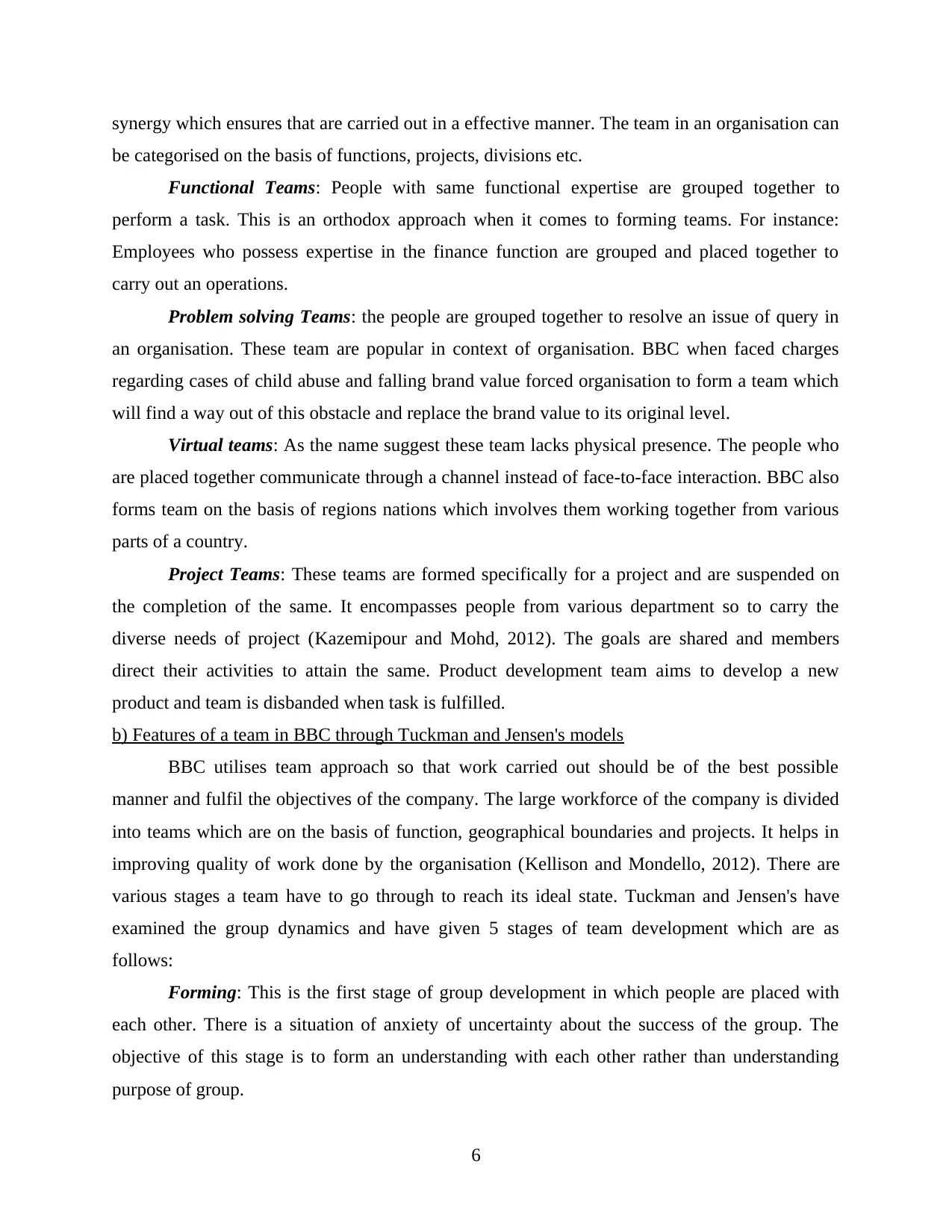
synergy which ensures that are carried out in a effective manner. The team in an organisation can
be categorised on the basis of functions, projects, divisions etc.
Functional Teams: People with same functional expertise are grouped together to
perform a task. This is an orthodox approach when it comes to forming teams. For instance:
Employees who possess expertise in the finance function are grouped and placed together to
carry out an operations.
Problem solving Teams: the people are grouped together to resolve an issue of query in
an organisation. These team are popular in context of organisation. BBC when faced charges
regarding cases of child abuse and falling brand value forced organisation to form a team which
will find a way out of this obstacle and replace the brand value to its original level.
Virtual teams: As the name suggest these team lacks physical presence. The people who
are placed together communicate through a channel instead of face-to-face interaction. BBC also
forms team on the basis of regions nations which involves them working together from various
parts of a country.
Project Teams: These teams are formed specifically for a project and are suspended on
the completion of the same. It encompasses people from various department so to carry the
diverse needs of project (Kazemipour and Mohd, 2012). The goals are shared and members
direct their activities to attain the same. Product development team aims to develop a new
product and team is disbanded when task is fulfilled.
b) Features of a team in BBC through Tuckman and Jensen's models
BBC utilises team approach so that work carried out should be of the best possible
manner and fulfil the objectives of the company. The large workforce of the company is divided
into teams which are on the basis of function, geographical boundaries and projects. It helps in
improving quality of work done by the organisation (Kellison and Mondello, 2012). There are
various stages a team have to go through to reach its ideal state. Tuckman and Jensen's have
examined the group dynamics and have given 5 stages of team development which are as
follows:
Forming: This is the first stage of group development in which people are placed with
each other. There is a situation of anxiety of uncertainty about the success of the group. The
objective of this stage is to form an understanding with each other rather than understanding
purpose of group.
6
be categorised on the basis of functions, projects, divisions etc.
Functional Teams: People with same functional expertise are grouped together to
perform a task. This is an orthodox approach when it comes to forming teams. For instance:
Employees who possess expertise in the finance function are grouped and placed together to
carry out an operations.
Problem solving Teams: the people are grouped together to resolve an issue of query in
an organisation. These team are popular in context of organisation. BBC when faced charges
regarding cases of child abuse and falling brand value forced organisation to form a team which
will find a way out of this obstacle and replace the brand value to its original level.
Virtual teams: As the name suggest these team lacks physical presence. The people who
are placed together communicate through a channel instead of face-to-face interaction. BBC also
forms team on the basis of regions nations which involves them working together from various
parts of a country.
Project Teams: These teams are formed specifically for a project and are suspended on
the completion of the same. It encompasses people from various department so to carry the
diverse needs of project (Kazemipour and Mohd, 2012). The goals are shared and members
direct their activities to attain the same. Product development team aims to develop a new
product and team is disbanded when task is fulfilled.
b) Features of a team in BBC through Tuckman and Jensen's models
BBC utilises team approach so that work carried out should be of the best possible
manner and fulfil the objectives of the company. The large workforce of the company is divided
into teams which are on the basis of function, geographical boundaries and projects. It helps in
improving quality of work done by the organisation (Kellison and Mondello, 2012). There are
various stages a team have to go through to reach its ideal state. Tuckman and Jensen's have
examined the group dynamics and have given 5 stages of team development which are as
follows:
Forming: This is the first stage of group development in which people are placed with
each other. There is a situation of anxiety of uncertainty about the success of the group. The
objective of this stage is to form an understanding with each other rather than understanding
purpose of group.
6
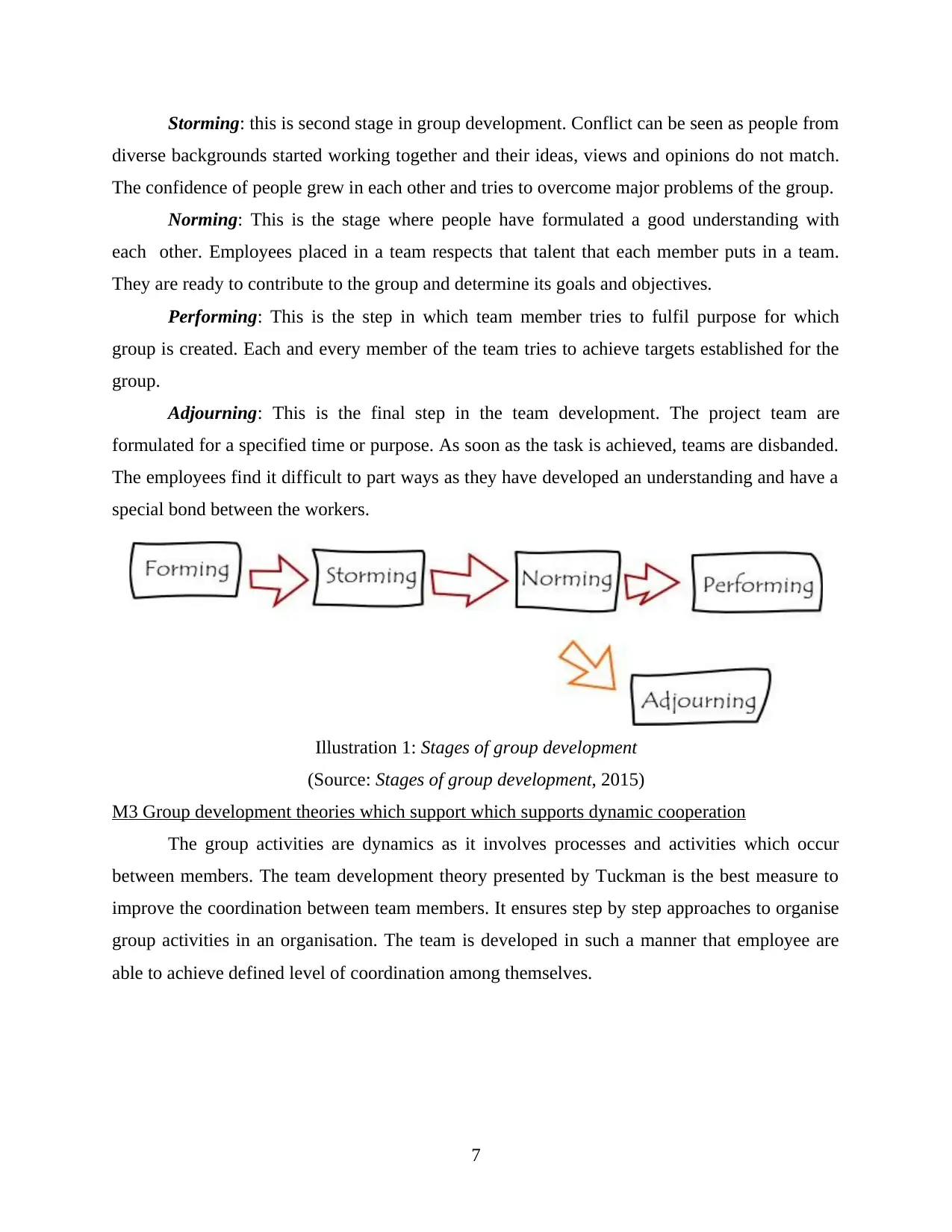
Storming: this is second stage in group development. Conflict can be seen as people from
diverse backgrounds started working together and their ideas, views and opinions do not match.
The confidence of people grew in each other and tries to overcome major problems of the group.
Norming: This is the stage where people have formulated a good understanding with
each other. Employees placed in a team respects that talent that each member puts in a team.
They are ready to contribute to the group and determine its goals and objectives.
Performing: This is the step in which team member tries to fulfil purpose for which
group is created. Each and every member of the team tries to achieve targets established for the
group.
Adjourning: This is the final step in the team development. The project team are
formulated for a specified time or purpose. As soon as the task is achieved, teams are disbanded.
The employees find it difficult to part ways as they have developed an understanding and have a
special bond between the workers.
(Source: Stages of group development, 2015)
M3 Group development theories which support which supports dynamic cooperation
The group activities are dynamics as it involves processes and activities which occur
between members. The team development theory presented by Tuckman is the best measure to
improve the coordination between team members. It ensures step by step approaches to organise
group activities in an organisation. The team is developed in such a manner that employee are
able to achieve defined level of coordination among themselves.
7
Illustration 1: Stages of group development
diverse backgrounds started working together and their ideas, views and opinions do not match.
The confidence of people grew in each other and tries to overcome major problems of the group.
Norming: This is the stage where people have formulated a good understanding with
each other. Employees placed in a team respects that talent that each member puts in a team.
They are ready to contribute to the group and determine its goals and objectives.
Performing: This is the step in which team member tries to fulfil purpose for which
group is created. Each and every member of the team tries to achieve targets established for the
group.
Adjourning: This is the final step in the team development. The project team are
formulated for a specified time or purpose. As soon as the task is achieved, teams are disbanded.
The employees find it difficult to part ways as they have developed an understanding and have a
special bond between the workers.
(Source: Stages of group development, 2015)
M3 Group development theories which support which supports dynamic cooperation
The group activities are dynamics as it involves processes and activities which occur
between members. The team development theory presented by Tuckman is the best measure to
improve the coordination between team members. It ensures step by step approaches to organise
group activities in an organisation. The team is developed in such a manner that employee are
able to achieve defined level of coordination among themselves.
7
Illustration 1: Stages of group development
⊘ This is a preview!⊘
Do you want full access?
Subscribe today to unlock all pages.

Trusted by 1+ million students worldwide

TASK 4
P4 Application of concepts and philosophies of organisational behavioural on business
a) Application of path goal theory to improve team performance
Path goal leadership theory aims to identify leadership style and behaviour which are best
suited to current business environment. The suitability is ensured so that goals and objectives are
fulfilled. The emphasis of this approach is on motivation and satisfaction of employees working
for an organisation (Raes and et. al., 2015). The first step of this theory is to assess present
circumstances of the company. BBC is presently going through a major structural change and
have been charged with child abuse cases.
In this present scenario, Participative style of leadership is best suited as it involves
opinion and views of employees in the decision making. The company have failed to form a
effective communication channel which prevented employees to share how they were feeling on
the policies and decision formulated by the company.
Providing support is one of the best measure in present scenario to motivate the
employees in the present scenario. Employees have low morale considering the cases of child
abuse. So the best way to boost the morale is to provide support to achieve the task and
objectives specified.
b) Barriers to effective performance
Barriers are the obstacles faced by employees in completing task. BBC have also faced
with some barriers in ideal performance which are :
Centralised control: Power in an organisation lies with management only. The
application of participative approach in its functioning help in overcoming barriers to effective
team performance.
Lack of channel of communication: Communication channel is essential feature which
helps in overcoming issues and hurdles in employee performance (Coccia, 2014). The employee
were not able to convey their views and opinions to the management. Installation of effective
channel of communication will help an organisation to remove barriers to ideal team
performance.
M4 Influence of organisational behaviour's policies and theories
The application of theories play a crucial role in business organisation. It influences
positive outcomes in field of improved personality, job satisfaction, and better management of
8
P4 Application of concepts and philosophies of organisational behavioural on business
a) Application of path goal theory to improve team performance
Path goal leadership theory aims to identify leadership style and behaviour which are best
suited to current business environment. The suitability is ensured so that goals and objectives are
fulfilled. The emphasis of this approach is on motivation and satisfaction of employees working
for an organisation (Raes and et. al., 2015). The first step of this theory is to assess present
circumstances of the company. BBC is presently going through a major structural change and
have been charged with child abuse cases.
In this present scenario, Participative style of leadership is best suited as it involves
opinion and views of employees in the decision making. The company have failed to form a
effective communication channel which prevented employees to share how they were feeling on
the policies and decision formulated by the company.
Providing support is one of the best measure in present scenario to motivate the
employees in the present scenario. Employees have low morale considering the cases of child
abuse. So the best way to boost the morale is to provide support to achieve the task and
objectives specified.
b) Barriers to effective performance
Barriers are the obstacles faced by employees in completing task. BBC have also faced
with some barriers in ideal performance which are :
Centralised control: Power in an organisation lies with management only. The
application of participative approach in its functioning help in overcoming barriers to effective
team performance.
Lack of channel of communication: Communication channel is essential feature which
helps in overcoming issues and hurdles in employee performance (Coccia, 2014). The employee
were not able to convey their views and opinions to the management. Installation of effective
channel of communication will help an organisation to remove barriers to ideal team
performance.
M4 Influence of organisational behaviour's policies and theories
The application of theories play a crucial role in business organisation. It influences
positive outcomes in field of improved personality, job satisfaction, and better management of
8
Paraphrase This Document
Need a fresh take? Get an instant paraphrase of this document with our AI Paraphraser
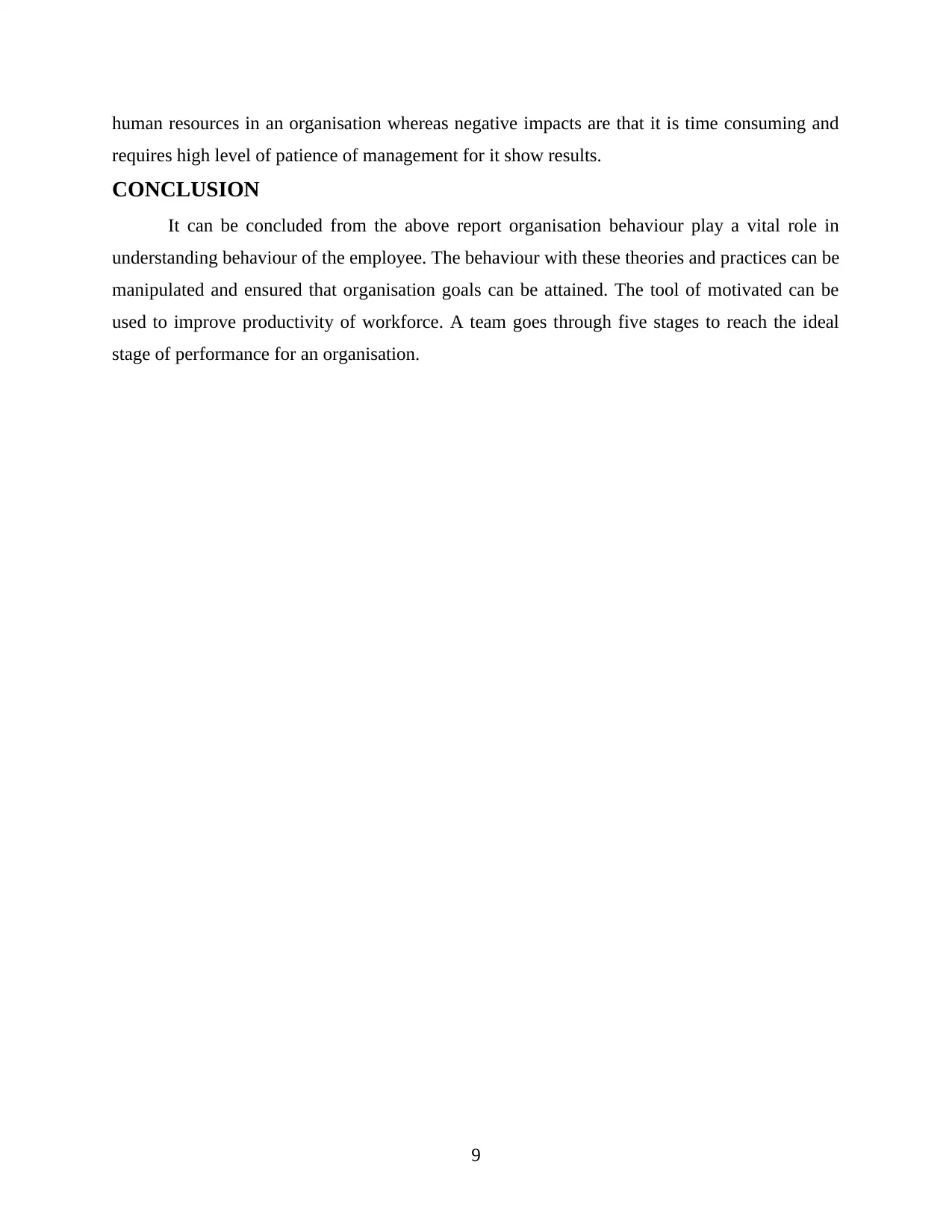
human resources in an organisation whereas negative impacts are that it is time consuming and
requires high level of patience of management for it show results.
CONCLUSION
It can be concluded from the above report organisation behaviour play a vital role in
understanding behaviour of the employee. The behaviour with these theories and practices can be
manipulated and ensured that organisation goals can be attained. The tool of motivated can be
used to improve productivity of workforce. A team goes through five stages to reach the ideal
stage of performance for an organisation.
9
requires high level of patience of management for it show results.
CONCLUSION
It can be concluded from the above report organisation behaviour play a vital role in
understanding behaviour of the employee. The behaviour with these theories and practices can be
manipulated and ensured that organisation goals can be attained. The tool of motivated can be
used to improve productivity of workforce. A team goes through five stages to reach the ideal
stage of performance for an organisation.
9
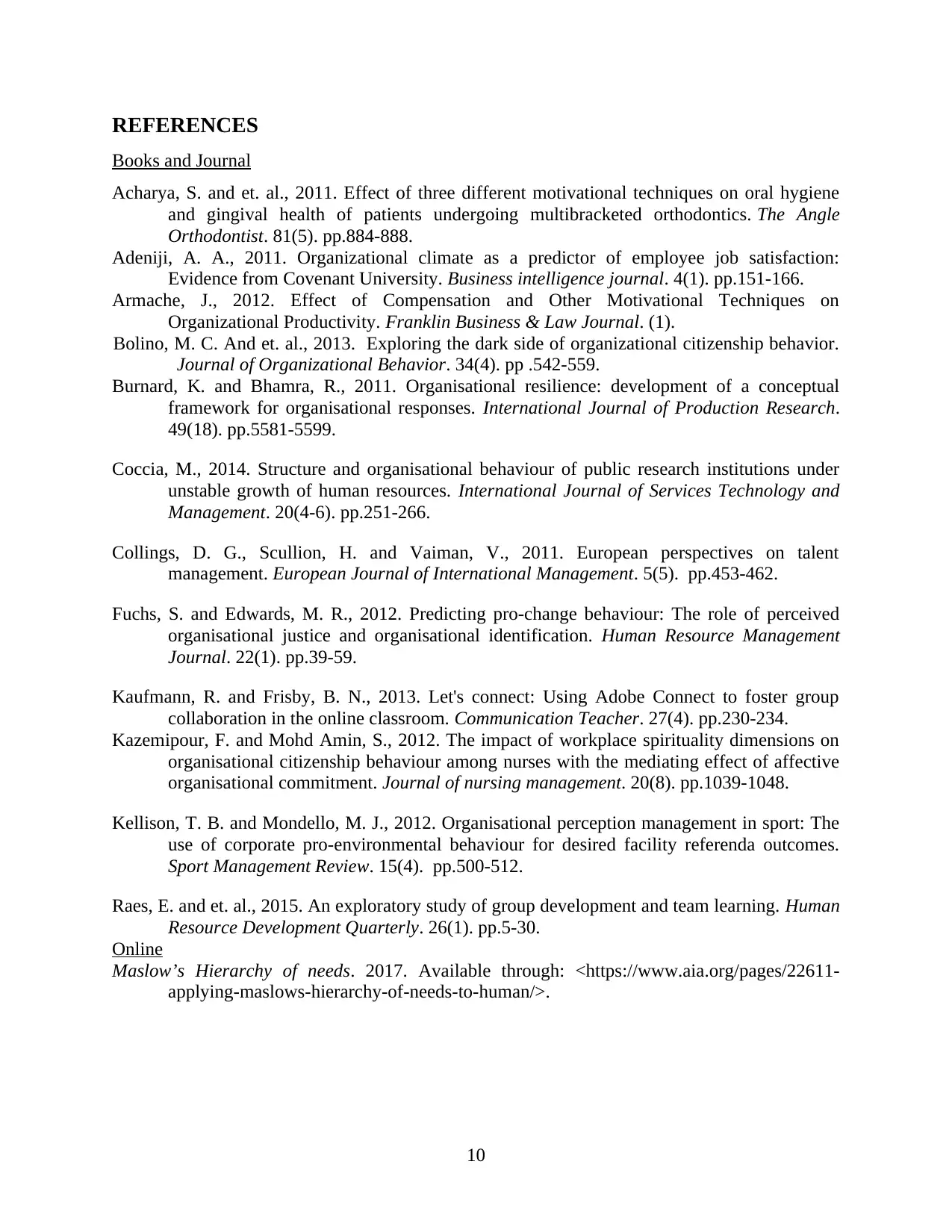
REFERENCES
Books and Journal
Acharya, S. and et. al., 2011. Effect of three different motivational techniques on oral hygiene
and gingival health of patients undergoing multibracketed orthodontics. The Angle
Orthodontist. 81(5). pp.884-888.
Adeniji, A. A., 2011. Organizational climate as a predictor of employee job satisfaction:
Evidence from Covenant University. Business intelligence journal. 4(1). pp.151-166.
Armache, J., 2012. Effect of Compensation and Other Motivational Techniques on
Organizational Productivity. Franklin Business & Law Journal. (1).
Bolino, M. C. And et. al., 2013. Exploring the dark side of organizational citizenship behavior.
Journal of Organizational Behavior. 34(4). pp .542-559.
Burnard, K. and Bhamra, R., 2011. Organisational resilience: development of a conceptual
framework for organisational responses. International Journal of Production Research.
49(18). pp.5581-5599.
Coccia, M., 2014. Structure and organisational behaviour of public research institutions under
unstable growth of human resources. International Journal of Services Technology and
Management. 20(4-6). pp.251-266.
Collings, D. G., Scullion, H. and Vaiman, V., 2011. European perspectives on talent
management. European Journal of International Management. 5(5). pp.453-462.
Fuchs, S. and Edwards, M. R., 2012. Predicting pro‐change behaviour: The role of perceived
organisational justice and organisational identification. Human Resource Management
Journal. 22(1). pp.39-59.
Kaufmann, R. and Frisby, B. N., 2013. Let's connect: Using Adobe Connect to foster group
collaboration in the online classroom. Communication Teacher. 27(4). pp.230-234.
Kazemipour, F. and Mohd Amin, S., 2012. The impact of workplace spirituality dimensions on
organisational citizenship behaviour among nurses with the mediating effect of affective
organisational commitment. Journal of nursing management. 20(8). pp.1039-1048.
Kellison, T. B. and Mondello, M. J., 2012. Organisational perception management in sport: The
use of corporate pro-environmental behaviour for desired facility referenda outcomes.
Sport Management Review. 15(4). pp.500-512.
Raes, E. and et. al., 2015. An exploratory study of group development and team learning. Human
Resource Development Quarterly. 26(1). pp.5-30.
Online
Maslow’s Hierarchy of needs. 2017. Available through: <https://www.aia.org/pages/22611-
applying-maslows-hierarchy-of-needs-to-human/>.
10
Books and Journal
Acharya, S. and et. al., 2011. Effect of three different motivational techniques on oral hygiene
and gingival health of patients undergoing multibracketed orthodontics. The Angle
Orthodontist. 81(5). pp.884-888.
Adeniji, A. A., 2011. Organizational climate as a predictor of employee job satisfaction:
Evidence from Covenant University. Business intelligence journal. 4(1). pp.151-166.
Armache, J., 2012. Effect of Compensation and Other Motivational Techniques on
Organizational Productivity. Franklin Business & Law Journal. (1).
Bolino, M. C. And et. al., 2013. Exploring the dark side of organizational citizenship behavior.
Journal of Organizational Behavior. 34(4). pp .542-559.
Burnard, K. and Bhamra, R., 2011. Organisational resilience: development of a conceptual
framework for organisational responses. International Journal of Production Research.
49(18). pp.5581-5599.
Coccia, M., 2014. Structure and organisational behaviour of public research institutions under
unstable growth of human resources. International Journal of Services Technology and
Management. 20(4-6). pp.251-266.
Collings, D. G., Scullion, H. and Vaiman, V., 2011. European perspectives on talent
management. European Journal of International Management. 5(5). pp.453-462.
Fuchs, S. and Edwards, M. R., 2012. Predicting pro‐change behaviour: The role of perceived
organisational justice and organisational identification. Human Resource Management
Journal. 22(1). pp.39-59.
Kaufmann, R. and Frisby, B. N., 2013. Let's connect: Using Adobe Connect to foster group
collaboration in the online classroom. Communication Teacher. 27(4). pp.230-234.
Kazemipour, F. and Mohd Amin, S., 2012. The impact of workplace spirituality dimensions on
organisational citizenship behaviour among nurses with the mediating effect of affective
organisational commitment. Journal of nursing management. 20(8). pp.1039-1048.
Kellison, T. B. and Mondello, M. J., 2012. Organisational perception management in sport: The
use of corporate pro-environmental behaviour for desired facility referenda outcomes.
Sport Management Review. 15(4). pp.500-512.
Raes, E. and et. al., 2015. An exploratory study of group development and team learning. Human
Resource Development Quarterly. 26(1). pp.5-30.
Online
Maslow’s Hierarchy of needs. 2017. Available through: <https://www.aia.org/pages/22611-
applying-maslows-hierarchy-of-needs-to-human/>.
10
⊘ This is a preview!⊘
Do you want full access?
Subscribe today to unlock all pages.

Trusted by 1+ million students worldwide
1 out of 13
Related Documents
Your All-in-One AI-Powered Toolkit for Academic Success.
+13062052269
info@desklib.com
Available 24*7 on WhatsApp / Email
![[object Object]](/_next/static/media/star-bottom.7253800d.svg)
Unlock your academic potential
Copyright © 2020–2025 A2Z Services. All Rights Reserved. Developed and managed by ZUCOL.





